INDIANAPOLIS – The 102nd Running of the Indianapolis 500 presented by PennGrade Motor Oil on Sunday marks the end of a 54-year era for ABC televising “The Greatest Spectacle in Racing.”
It’s a partnership of a sporting event and network exceeded in length only by CBS and The Masters golf tournament.
 ABC’s coverage has come a long way since reporter Chris Schenkel, an Indiana native, convinced good friend Tony Hulman, the Indianapolis Motor Speedway owner, that television wouldn’t diminish ticket sales back in 1965. Over the years, greats such as Jim McKay, Chris Economaki, Jackie Stewart, Al Michaels, Brent Musburger and even David Letterman have been part of the ABC race broacast.
ABC’s coverage has come a long way since reporter Chris Schenkel, an Indiana native, convinced good friend Tony Hulman, the Indianapolis Motor Speedway owner, that television wouldn’t diminish ticket sales back in 1965. Over the years, greats such as Jim McKay, Chris Economaki, Jackie Stewart, Al Michaels, Brent Musburger and even David Letterman have been part of the ABC race broacast.
Sunday’s production (prerace show airs 11 a.m. ET, green flag at 12:19 p.m.) will use a record 110 cameras, including on-board shots from 14 drivers, as well as the support of 150 technical crew members and 210 microphones.
As ABC concludes its proud legacy of innovation to give way to NBC next year, four men who have contributed to the broadcasts shared their most memorable moments.
Paul Page, play-by-play announcer
Longtime radio voice Page was hired to bring more knowledgeable racing insight to ABC in 1988. He and legendary producer Don Ohlmeyer, who called the shots as a director, put their heads together on how to improve the live broadcast.
“Don and I changed everything,” Page said. “They had too many trucks, too many people. I said, ‘When you’re covering a race, you’ve got to slim this down. You can’t wait for A to talk to B to talk to C to tell D to put something on the air.’ We slimmed it down.
“I came up with a device that is in common use now, the announcer panel. It had one cough button and then two dials to control the volume in each ear. You’re getting what they’re talking to you about from the truck. I arranged so we also had a talk-back (button). My point was we see things in the booth that you guys don’t see. You may have the best spotters in the world, but we have an awfully good sense for what’s going on. Now I could just hit that button, it takes me off the air, and I can say, ‘Get on (car No.) 98.’”
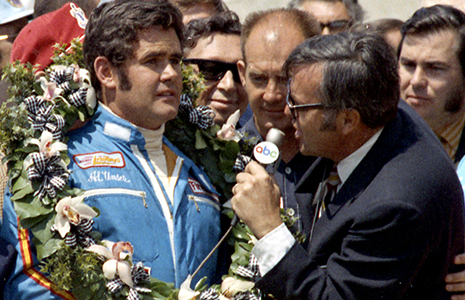 ABC won Emmys for best sports special the next two years.
ABC won Emmys for best sports special the next two years.
Page, 72, remembers his last time in the ABC booth in 2004, when rain delays made it the longest of days. Buddy Rice eventually prevailed after completing 450 miles as another severe thunderstorm approached.
“Eight hours and 20 minutes we were on the air,” Page said. “And we left under a tornado warning.”
Page enjoyed working in the booth with three-time Indy 500 winner Bobby Unser and Sam Posey. He recalled with a laugh how he threw aside Posey’s stack of 5x7 information cards to make the point that insights needed to be spontaneous and not scripted.
“Just before we go on the air, I walked over and took the stack and threw them down to the end of the booth,” Page said. “It was the best damn day he ever had, but you should have seen his face.”
Another time, Unser couldn’t get the color right on his TV monitor, so he was watching Page’s screen. He got too close. Page turned quickly and knocked Unser off his chair.
“Bobby, I’m so sorry,” Page said.
Page organized an annual tea party for final production meetings. One year, the table centerpiece was the Borg-Warner Trophy, the Stanley Cup and America’s Cup.
He will always appreciate the creativity put into ABC’s telecasts, like using what he called an “ant-cam” for the unique on-track view from inside Turn 1. On race day, the grass is trimmed with scissors to make sure the angle isn't compromised.
“They were absolutely pioneers,” Page said. “They worked out camera angles and stuff as a viewer you don’t really see, but if you’re in the production and you realize that if we move that camera 10 feet to the left, it made all the difference in the world. They had to do that, and they had to do it on a yearly basis. They pioneered television coverage of motorsports.”
Dr. Jerry Punch, pit reporter
As he prepared for his 27th Indy 500 for ABC this year, Punch went back to his debut in 1989, when Emerson Fittipaldi and Al Unser Jr. touched wheels in Turn 3 on Lap 199. Little Al spun out and Emmo won.
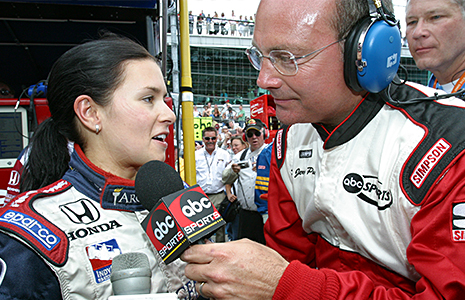 It made sense to send Punch, who is also a medical doctor, to the infield medical center to await Unser.
It made sense to send Punch, who is also a medical doctor, to the infield medical center to await Unser.
“I had every ABC executive in New York in my ear,” he said. “Everyone was telling me what to ask. They’re talking to the rookie at Indy, and it’s a critical point. Here Little Al comes walking out. There are so many people talking to me in my earpiece, and I thought to myself, ‘If I don’t know what to ask, I probably shouldn’t be here right now.’ I pull one of my earpieces out so I can concentrate.”
Punch was impressed by how Unser was gracious in defeat, congratulating Fittipaldi.
“Then he said, ‘It is hopefully my destiny as an Unser to win this race someday, as my dad and uncle have done. It just wasn’t to be today, but hopefully my day will come,’” Punch said. “Incredible, incredible class and dignity.”
When Punch reinserted his earpiece, executives were ecstatic.
“We’re getting all these ‘atta boys’ and high-fives from ABC for what I had done,” he said. “Everybody had thought they had given me their question when I had actually pulled the earpiece off so I could think.”
Fast forward to 1992, when Unser earned his first of two Indy 500 victories, this one a nail-biter by 43-thousands of a second over Scott Goodyear, who is now an ABC analyst.
“When Little Al stood in victory lane and said, ‘You just don’t know what Indy means,’” Punch said, “I knew what it meant because I saw it in his eyes when he didn’t get a chance to win it in 1989.”
As a kid who used to watch the race on a black-and-white television in North Carolina, Punch has so many cherished memories. He recalls the look on Bev Patrick’s face when her daughter, Danica, took the lead late in the 2005 Indy 500. He could also see how Muhammad Ali recognized the uniqueness of IMS and this race.
Another interaction that stands out was with Hall of Fame quarterback Joe Montana, a four-time Super Bowl winner.
“He’s shivering. It’s a little overcast and windy, typical May,” Punch said. “I said, ‘Joe, if you’re a little cool, we’ve got a little ABC jacket blazer we can give you.’ He said: ‘No, Doc, I’m not cool. I’m shaking from emotion.’
“He looked up and down the front straight and sees this massive tidal wave of people and he says, ‘Think about it, there’s more people here right now than in all four Super Bowls I played in combined.’”
Bobby Unser, analyst
He’s always been known for never pulling any punches, so when Unser was hired to provide race insights from the television booth in 1987, many were convinced he wouldn’t last long.
“I’ve always cussed a lot,” said Unser, 84. “On TV, some of them would make bets with each other. A lot of the guys would predict that Unser would never make it. He’ll cuss and get fired, and that will be the end of it.
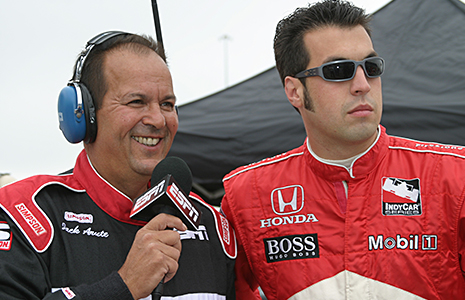 “I went through all of those years and never said a cuss word (on the air). I don’t know how. I guess it’s concentration. What else could it be? The mechanics didn’t think I would make it. The drivers didn’t think I’d make it. Nobody thought I’d make it. I didn’t think I would make it, either.”
“I went through all of those years and never said a cuss word (on the air). I don’t know how. I guess it’s concentration. What else could it be? The mechanics didn’t think I would make it. The drivers didn’t think I’d make it. Nobody thought I’d make it. I didn’t think I would make it, either.”
He laughs about how he was on the air for 11 consecutive Indy 500s through 1997.
One of his most memorable experiences was when ABC positioned Unser atop the Turn 2 suites in 1993. Considering Unser’s admitted fear of heights, he wasn’t thrilled with the idea. Nor did he care for the fact that producer Bob Goodrich arranged for just three passes for him, a cameraman and an assistant.
Unser had other ideas on making himself comfortable up there.
“The camera spun over to Turn 2 and that damn Bobby Unser had tables, chairs, umbrellas, girls, guys, food,” Unser said. “Jug’s was the caterer. Jug’s was one of our best friends. Why would you tell Jug’s you can’t take food up to Bobby Unser? That was too easy. (Laughs.) These Yellow Shirts (on the IMS Safety Patrol), they’ve known me since I was a kid. They’re not going to tell me that Bobby can’t have whatever he wants up on that roof.
“The camera goes over there, and Goodrich sees all of this and he screams at Paul Page. Paul says that’s his problem, he was the one to tell me I couldn’t have anybody up there. Goodrich just gave up.”
Unser was afraid before his first time in the booth but credits Page and Ohlmeyer for helping him adjust.
“It became fun,” he said. “The first race, it scares the crap out of you. I had never done that before. You’re on live TV. What am I going to talk about? What do they expect you to say? I don’t know what I’m going to say. My life has always been talking to people and stating what I wanted.”
Rich Feinberg, producer
Feinberg, now the senior vice president/executive producer at IMS Productions, worked his first race for ABC in 1986 as a production gofer. He did whatever was needed, carrying luggage, grabbing press releases, even fetching water for pit reporter Jack Arute.
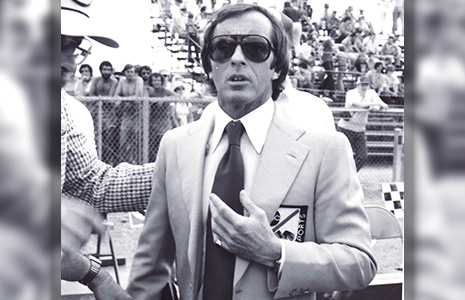 Feinberg eventually had one of the most unique vantage points, working with Ohlmeyer among others behind the scenes. He served as ABC's executive producer of the Indy 500 from 2004 to 2014.
Feinberg eventually had one of the most unique vantage points, working with Ohlmeyer among others behind the scenes. He served as ABC's executive producer of the Indy 500 from 2004 to 2014.
“My memories are more of just year after year always being amazed at what a spectacle this place is, the size and the scope of it,” Feinberg said. “It’s exceeded my memory each year that I came back. Just great storylines. This place has an amazing lineage to it as a storyteller and a TV producer. It’s fertile with opportunity.”
He remembers something Ohlmeyer once said about what it was like to organize the production.
“One of the things he used to say about directors in television motorsports is that they’ll make more decisions in one race than most humans will make in six months of their lives,” Feinberg said. “As a producer, you’re more of the conductor of the orchestra. You have the announcers, the cameramen, the replays and the features. You look at it collectively.
“What most people don’t know is the number of cameras, technicians and special technology far exceeds anything that’s ever been used on a Super Bowl. It is a big, complicated production.”
Think about how a director might call for 12 camera shots in one lap, then multiply that over the course of 200 laps. And the snap decisions are made in seconds for more than three hours.
“It’s just instinct,” he said. “And it never, ever stops. It’s a real art. Everybody knows when you get it wrong. They shouldn’t be thinking about it when you get it right. It’s just a seamless show. When it’s great racing, you get out of the way and let it play out for the fans.
“I’ve always felt like we did it really well, but I never walked out of the truck without a mental list of what we could do better. Live television is really hard, and auto racing is as hard as it gets. The competition doesn’t stop when we go to break. There’s a sixth sense required and an art to trying to figure out how to not go at the wrong time.”
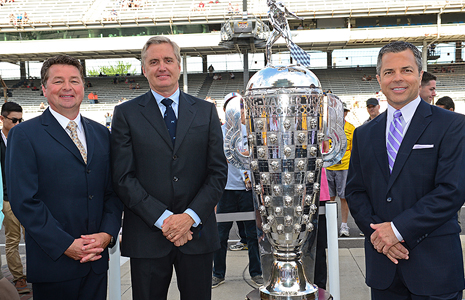 Feinberg was particularly proud of being part of the group that came up with today’s side-by-side commercial breaks, where the race is still broadcast on one side of the screen while commercials are played on the other.
Feinberg was particularly proud of being part of the group that came up with today’s side-by-side commercial breaks, where the race is still broadcast on one side of the screen while commercials are played on the other.
“It wasn’t just a conceptual thing that we as producers could think of,” Feinberg said. “We had to convince the advertising community that their message wouldn’t be de-valued and, in fact, would maybe actually be appreciated greater.”
Everyone who has worked on ABC’s Indy 500 broadcasts shared a common bond.
“I’ll remember ABC as the organization for 54 years that respected the privilege to document this event for the world,” Feinberg said. “Everybody who I worked with and you can sense it in me, Ohlmeyer said it, Page said it, Goodrich said it and (announcer) Al Michaels said it, it was a privilege to do this event.
“When you come through the gates here, you feel something unique and special. And I’m here to work, I have an obligation to the community worldwide that experiences this to get it right and do it with class and dignity and seriousness while still having fun. This is still entertainment. I believe that is a consistent theme in the bloodline of everybody who has worked on this project over the 54 years.”
Allen Bestwick will call the race a final time in the ABC booth today, surrounded by race analysts Eddie Cheever and Scott Goodyear. Pit reporters will be Jon Beekhuis, Rick DeBruhl and Dr. Jerry Punch.
ABC Indianapolis 500 broadcast timeline:
- Charlie Brockman, an Indianapolis media personality who had called the closed-circuit broadcasts of the Indy 500 in previous years, is play-by-play announcer for the first telecast in 1965 on ABC’s Wide World of Sports.
- ABC veteran Chris Schenkel calls the 1966 race telecast.
- In 1967, the race appears in color for the first time and Jim McKay works the first of his 20 Indy 500 telecasts.
- In 1971, for the first time, ABC’s coverage of the Indianapolis 500 airs as a same-day, stand-alone, tape-delayed telecast in prime time rather than as part of the Wide World of Sports program.
- In 1983, Al Unser and Rick Mears carry onboard cameras, the first used in Indy 500 coverage.
- Also in 1983, Chris Economaki worked the last of his 16 races with ABC as either a pit reporter or analyst.
- In 1986, after many years of tape-delayed telecasts, the race is televised live for the first time.
- In 2004, several rain delays take the telecast to 8.5 hours, making for one of the longest single-event telecasts ever.
- Also in 2004, Jamie Little makes her debut as a pit reporter, the first woman ever in that role at the Indy 500.
- In 2007, the race is televised in high definition for the first time.
- The 100th anniversary Indianapolis 500 airs on ABC in 2011, the 47th consecutive year the network has televised the event.
- ABC airs the 100th running of the Indianapolis 500 in 2016. With the race sold out, the local blackout is lifted for the first time and Indianapolis ABC affiliate WRTV-TV televises the race live.
ABC Indianapolis 500 on-air talent:
Hosts: Chris Schenkel (1971-80), Dave Diles (1981), Jackie Stewart (1982-84), Jim McKay (1985-87), Paul Page (1988-98), Al Michaels (1999-2001), Bob Jenkins (2002-03), Terry Gannon (2004), Brent Musburger (2005-12), Lindsey Czarniak (2013-17), Nicole Briscoe (2018).
Play-by-play announcers: Charles Brockman (1965), Chris Schenkel (1966), Jim McKay (1967-74, 1976-85), Keith Jackson (1985), Jim Lampley (1986-87), Paul Page (1988-98, 2002-04), Bob Jenkins (1999-2001), Todd Harris (2005), Marty Reid (2006-13), Allen Bestwick (2014-18).
Analysts: Rodger Ward (1965, 1967-70), Jackie Stewart (1971-73, 1975, 1977-81), Chris Economaki (1973), Sam Posey (1974, 1976, 1982-95), Bobby Unser (1987-97), Danny Sullivan (1994, 1996-97), Tom Sneva (1997-2000), Jason Priestley (2001), Scott Goodyear (2002-18), Jack Arute (2004), Rusty Wallace (2006-07), Eddie Cheever (2008-18).
Pit reporters: Chris Economaki (1967, 1969-72, 1974-83), Bill Fleming (1971, 1974, 1976-78, 1982-85), Keith Jackson (1971), Dave Diles (1973, 1979-80), Don Hein (1973), Sam Posey (1975, 1978, 1980-81), Jack Whitaker (1982), Jack Arute (1984-98, 2000-03, 2005-09), Larry Nuber (1984, 1986-87), Al Trautwig (1986-87), Donna de Varona (1986), Jerry Gappens (1987), Dr. Jerry Punch (1989-2006, 2010-18), Gary Gerould (1990-99, 2002-04), Jon Beekhuis (1999, 2015-18), Vince Welch (2000-14), Leslie Gudel (2000-01), Jamie Little (2004-14), Todd Harris (2004), Penn Holderness (2005), Brienne Pedigo (2007-09), Rick DeBruhl (2010-18).
Turn reporter: David Letterman (1971).